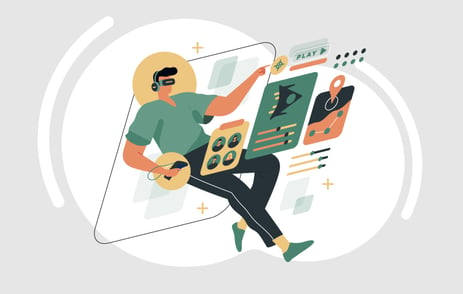As artificial intelligence (AI) advances, it is transforming how content is created, products are developed, and businesses strategize. As AI becomes a more integral part of creative processes, it raises important questions about ownership and intellectual property (IP). How do you protect something that was assisted or even entirely created by AI? Associations and businesses must navigate this landscape to effectively safeguard their latent assets and leverage the full potential of AI. Understanding how intellectual property rights apply to AI-generated creations is crucial because it can significantly impact innovation, competitive advantage, and business strategies in an era where the boundaries between human creativity and machine assistance are increasingly blurred.
Defining Latent Assets in AI-Generated Creations
Latent assets represent hidden or underutilized resources that AI can help unlock. For associations, these assets often reside in their vast reservoirs of data, rich archives of knowledge, and the power of their brand. With AI, associations can mine this existing content and data to gain fresh insights, deliver tailored member services, and innovate more efficiently. By strategically leveraging these assets, associations can establish a distinct competitive advantage that differentiates them. Associations can become the ultimate knowledge hubs in their verticals if they blend their trusted expertise with AI capabilities. This blend creates new value propositions and opens the door to new business models, turning once static archives into valuable, living resources that benefit members daily.
Intellectual Property Challenges with AI-Generated Creations
Navigating intellectual property protection for AI-generated creations presents several challenges, particularly in the areas of patent and copyright law.
- Patent Protection: Patents, traditionally designed to reward human ingenuity, can be difficult to secure for AI-generated inventions. This complexity is due to the need for novelty and non-obviousness. An invention generated entirely by AI may struggle to meet these requirements if it appears that the underlying AI model, rather than a human, performed most of the creative work. Despite these challenges, patents can still provide strategic value by signaling innovation, serving as a defensive moat, and facilitating licensing or partnerships.
- Copyright Protection: Determining the extent of human contribution in AI-generated content remains an evolving legal matter. Copyright law currently requires a clear indication of human authorship, but with AI playing an increasing role in content creation, distinguishing between human and AI contributions is increasingly difficult. This ambiguity challenges the ability to secure copyright protection for purely AI-generated works. Associations and businesses should ensure that human involvement is evident in their AI-assisted content to enhance its protectability under current copyright laws.
These challenges underscore the need for organizations to rethink their strategies for securing ownership and protection of their AI-generated works. Balancing human creativity with machine assistance will be crucial in navigating the evolving landscape of intellectual property rights.
Leveraging Trade Secrets and Contracts
In the absence of clear guidelines on patent and copyright protection, associations and businesses can turn to other forms of intellectual property protection, such as trade secrets and contractual agreements. Trade secrets offer a robust way to protect proprietary AI algorithms, training data, and unique datasets. Unlike patents, trade secrets don't require public disclosure, allowing organizations to maintain their competitive edge through secrecy. However, the risk lies in maintaining that secrecy over time.
Contracts, such as end-user license agreements, are also essential in clarifying ownership, usage rights, and obligations regarding AI-generated works. For instance, associations can use licensing agreements to specify how members or external parties can access and use AI-generated content or tools while preserving ownership of their core algorithms and datasets. By combining trade secret protection with strong contractual frameworks, associations can establish a controlled environment to safeguard their intellectual assets.
These strategies help associations establish a clear and enforceable structure around their intellectual property, even as AI blurs the lines between human and machine-generated creations.
Creating and Protecting a Moat
In the competitive landscape of associations, leveraging AI to build and protect a strategic moat is crucial. A moat, in this context, refers to the sustainable competitive advantage that differentiates an organization from its rivals. For associations, the ability to harness AI tools, combine them with proprietary data, and deliver innovative services can create a formidable barrier against competitors.
Associations should think of themselves as knowledge centers, where the combination of brand credibility, specialized expertise, and proprietary data can create a unique value proposition. By leveraging AI to synthesize this knowledge into easily accessible and customized formats, associations can engage members daily through tailored insights, training programs, or co-pilot-style assistants that enrich their professions.
To protect this moat, associations must establish strong IP protections through patents, copyrights, and trade secrets, backed by carefully crafted contractual frameworks. These measures, coupled with constant innovation in AI applications, will help associations fortify their competitive advantage and adapt to an evolving technological landscape.
Navigating the Regulatory Landscape
The regulatory landscape surrounding AI-generated intellectual property is rapidly evolving, making it essential for associations and businesses to stay informed and proactive. Courts and IP offices globally are grappling with the unprecedented challenges posed by AI-generated content. The U.S. Patent Office and copyright regulators are actively debating issues such as whether AI can be listed as an inventor and the degree of human involvement required for copyright eligibility.
Patent and copyright offices are currently attempting to devise frameworks to address these concerns. While there's no definitive global consensus yet, it's clear that organizations need to adapt their IP strategies. Associations should keep a close eye on legal developments to anticipate changes in how AI-generated works are regulated and develop internal guidelines for their content creation processes.
A proactive approach involves seeking expert advice, establishing clear policies on human involvement, and revising agreements with contributors to ensure compliance. By aligning their strategies with emerging regulations, associations can stay ahead of the curve, secure their rights, and minimize potential legal risks.
Conclusion
As AI becomes an integral part of creative processes, understanding how to own and protect AI-assisted creations is crucial for associations and businesses alike. By recognizing the value of latent assets, building strategic moats through proprietary data and services, and leveraging a mix of intellectual property protections such as patents, copyrights, and trade secrets, organizations can establish a strong position in this evolving landscape. The challenges surrounding AI-generated works will persist, but by proactively navigating this terrain, associations can harness AI to unlock new opportunities while ensuring their intellectual property remains safeguarded.
Ultimately, the organizations that adapt to this new environment will be well-positioned to lead their fields, providing innovative solutions that distinguish them from competitors and reinforcing their reputation as knowledge centers. Investing in the right legal frameworks and keeping abreast of regulatory changes will be essential as associations capitalize on AI’s transformative potential.
Looking to embark on your AI journey, but not sure where to start? Check out Sidecar’s Prompt Engineering Mini Course for tricks and tips on interacting with AI.

May 7, 2024


